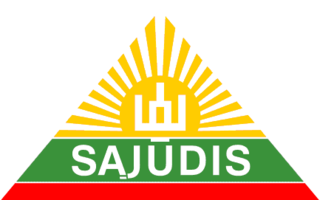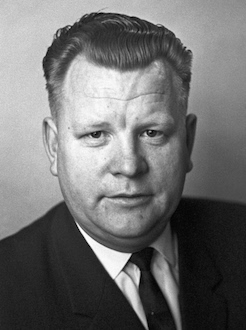
The Seimas of the Republic of Lithuania, or simply the Seimas, is the unicameral legislative body of the Republic of Lithuania. The Seimas constitutes the legislative branch of government in Lithuania, enacting laws and amendments to the Constitution, passing the budget, confirming the Prime Minister and the Government and controlling their activities.

Democratic Labour Party of Lithuania was the renamed Communist Party of Lithuania. It was a political party in Lithuania in the 1990s, which claimed to be social democratic. The youth organization of LDDP was called Lithuanian Labourist Youth Union.

Sąjūdis, initially known as the Reform Movement of Lithuania, is a political organisation which led the struggle for Lithuanian independence in the late 1980s and early 1990s. It was established on 3 June 1988 as the first opposition party in Soviet Lithuania, and was led by Vytautas Landsbergis. Its goal was to seek the return of independent status for Lithuania.

The Baltic Way or Baltic Chain was a peaceful political demonstration that occurred on 23 August 1989. Approximately two million people joined their hands to form a human chain spanning 690 kilometres (430 mi) across the three Baltic states of Estonia, Latvia and Lithuania, which at the time were occupied and annexed by the USSR and had a combined population of approximately eight million. The central government in Moscow considered the three Baltic countries constituent republics of the Soviet Union.

The Communist Party of Lithuania was a communist party in Lithuania. The party was established in early October 1918 and operated clandestinely until it was legalized in 1940 after the Soviet invasion and occupation. The party was banned in August 1991, following the coup attempt in Moscow, Soviet Union which later led to the collapse of the Soviet Union and the dissolution of the Lithuanian SSR.

Parliamentary elections were held in Lithuania on 10 October 2004, with a second round on 24 October 2004 in the constituencies where no candidate won a majority in the first round of voting. All 141 seats in the Seimas were up for election; 71 in single-seat constituencies elected by majority vote and the remaining 70 in a nationwide constituency based on proportional representation.

The Act of the Re-Establishment of the State of Lithuania or Act of 11 March was an independence declaration by Lithuania adopted on 11 March 1990, signed by all members of the Supreme Council of the Republic of Lithuania led by Sąjūdis. The act emphasized restoration and legal continuity of the interwar-period Lithuania, which was occupied by the Soviet Union and annexed in June 1940. In March 1990, it was the first of the 15 Soviet republics to declare independence, with the rest following to continue for 21 months, concluding with Kazakhstan's independence in 1991. These events led to the dissolution of the Soviet Union in December 1991.

The Supreme Soviet of the Lithuanian SSR was the supreme soviet of the Lithuanian SSR, one of the republics constituting the Soviet Union. The Supreme Soviet was established in August 1940 when the People's Seimas declared itself the provisional Supreme Soviet. According to the constitution it was very similar to modern democratic parliaments: it was elected every four years and had the power to create, amend and ratify the constitution, laws, and treaties and appoint officials in the Council of Ministers. However, in reality the elections were staged, the Soviet had very little actual power and carried out orders given by the Communist Party of Lithuania (CPL). The situation changed in 1988, when the Lithuanians began seeking independence from the Soviet Union. The political power shifted from CPL to the Soviet, which adopted a number of important constitutional amendments and laws, paving the way for the independence. The first free elections were held in February 1990 and were won by pro-independence Sąjūdis. During its first session the Supreme Soviet adopted the Act of the Re-Establishment of the State of Lithuania and renamed itself the Supreme Council of the Republic of Lithuania.
Vytautas Kolesnikovas was a painter, graphic artist, politician, and signatory of the 1990 Act of the Re-Establishment of the State of Lithuania.

Romualdas Ozolas [rɔmʊˈɐɫdɐs ˈoːzɔɫɐs] was a Lithuanian politician, activist, writer and pedagogue who taught at Vilnius University. He was of Latvian descent on his father's side.
The People's Parliaments or People's Assemblies were puppet legislatures put together after the show elections in Estonia, Latvia, and Lithuania to legitimize the occupation by the Soviet Union in July 1940. In all three countries, the elections to the parliaments followed the same script, dictated by functionaries in Moscow and borrowed from the examples of the incorporation of the Belarusian and Ukrainian lands into Soviet Union in the aftermath of the invasion of Poland in 1939.

Parliamentary elections were held in Lithuania in two stages on 25 October and 15 November 1992. A total of 141 members were elected to the Seimas, which replaced the Supreme Council; 70 were elected using proportional representation and 71 from single-member constituencies. Where no candidate in the single-member constituecies received more than 50% of the vote on 25 October, a run-off was held on 15 November. The first round of the elections were held simultaneously with a referendum on the adoption of a new constitution.
The Lithuanian Liberty League or LLL was a dissident organization in the Lithuanian Soviet Socialist Republic and a political party in independent Republic of Lithuania. Established as an underground resistance group in 1978, LLL was headed by Antanas Terleckas. Pro-independence LLL published anti-Soviet literature and organized protest rallies. While it enjoyed limited popularity in 1987–1989, it grew increasingly irrelevant after the independence declaration in 1990. It registered as a political party in November 1995 and participated in parliamentary elections without gaining any seats in the Seimas.
Presidential elections were held in Lithuania on 14 February 1993. They were the first presidential elections under the new October 1992 constitution and the first direct presidential elections in the country's history.

Vytautas Sakalauskas was a Lithuanian Soviet politician who was the last Chairman of the Council of Ministers of the Lithuanian Soviet Socialist Republic before Lithuanian independence in 1990.
The Sixth Seimas of Lithuania was the first parliament (Seimas) elected in Lithuania after it restored independence on 11 March 1990. Elections took place on 25 October 1992, with the second round on 15 November. In a surprisingly decisive outcome, the elections were won by Democratic Labour Party of Lithuania (LDDP), with 73 seats. The result reflected widespread dissatisfaction with the economic situation and the policies of the ruling Sąjūdis political movement in the preceding Supreme Council of Lithuania.

The day of restoration of Independence of Lithuania is a Lithuanian national holiday celebrated on 11 March in commemoration of the Act of the Re-Establishment of the State of Lithuania that the Constituent Assembly signed in 1990. It is one of the three principal national holidays in Lithuania, along with the Day of the Re-Establishment of the Statehood of Lithuania on 16 February and the Statehood Day on 6 July.

The Soviet economic blockade of Lithuania was imposed by the Soviet Union on Lithuania between 18 April and 2 July 1990.
Nikolai Mitkin was a figure of the Communist Party of the Soviet Union.

The Union of the Working People of Lithuania or Union of Lithuanian Working People was the front organization set up by the Communist Party of Lithuania after the Soviet occupation of Lithuania to take part in the rigged 1940 Lithuanian parliamentary election to the so-called "People's Seimas". The organization ceased to exist as soon as the elections passed.










